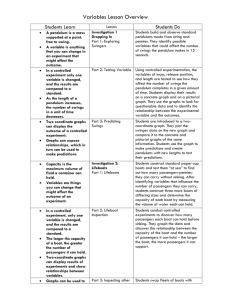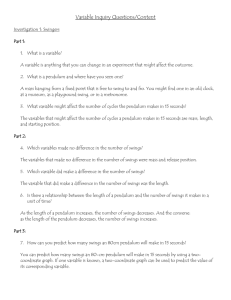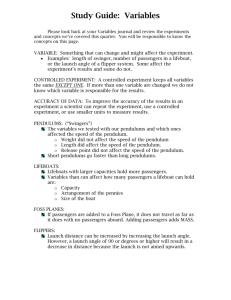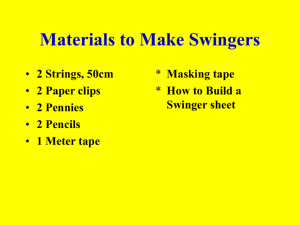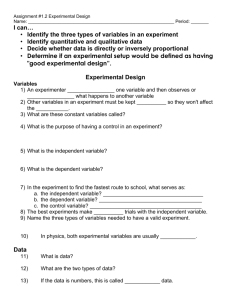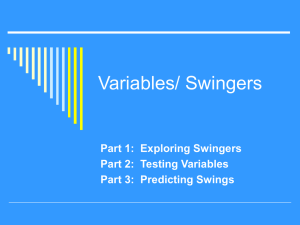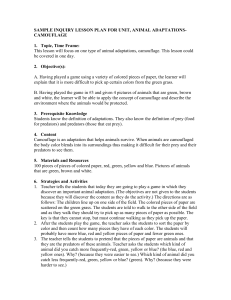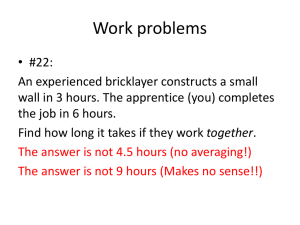Variables
advertisement
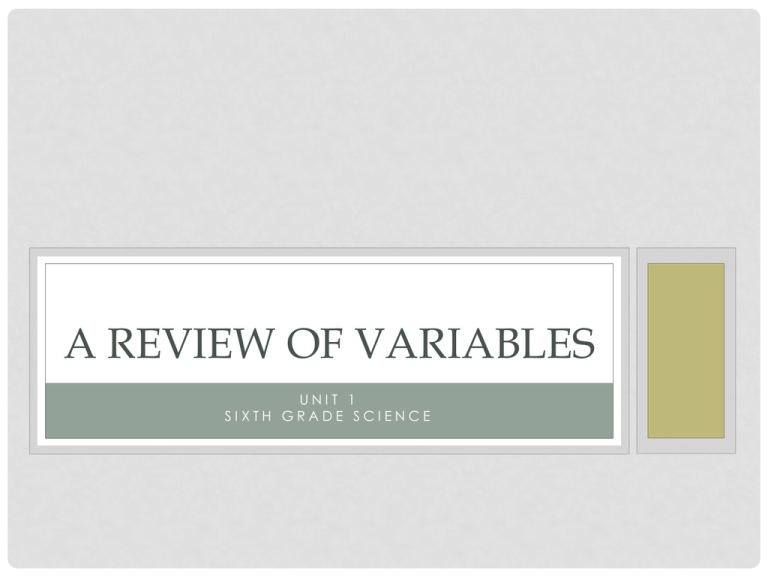
A REVIEW OF VARIABLES UNIT 1 SIXTH GRADE SCIENCE THE VARIABLE UNIVERSE • What is a variable? • A variable is anything that you can change that might affect the outcome of an experiment. • Examples: • In a car: body size and shape, tire size and shape, weight, fuel type, and color • In a house: shape, number of rooms, wall colors. Floor type, number of windows HOW DO WE DETERMINE THE BEHAVIOR OF VARIABLES? • Experimentation – • A scientist will investigate the effect variable have by conducting an experiment. MORE TERMS TO KNOW • Controlled experiment – When you change one variable at a time and keep all the other variables the same. • System – A set of objects that is working together. • Pendulum – Any mass suspended on a string, rope, or other arm that is free to pivot from an anchor point • Cycle – A complete rotation; for example, one complete swing back and forth • Independent Variable – The variable whose value determines the dependent variable. This is found along the x-axis on a two-coordinate graph. • Dependent Variable – a variable that is determined based on the independent variable. This is found along the y-axis on a tow-coordinate graph. MORE TERMS TO KNOW • Buoyancy – the ability to rise and float in a fluid. • Capacity – The maximum volume of fluid a container can hold. • Displacement – the fluid pushed out of a way when and object is placed in the fluid. (mass of the displaced fluid = the mass of the object placed in the fluid) INVESTIGATION 1: SWINGERS • What were the variables for the pendulum? • The length of the string • The release position • The mass at the end of the string • Which variable affected the number of swings? • The length of the string • We found that as the length of the pendulum increases, the number of swings in a unit of time decreases. As the pendulum decreases, the number of swings in a unit of time increases. • How do we show the relationship between the number of swings in a given time and the length of the swing? • We use a two-coordinate graph, which also helps us make predictions. INVESTIGATION 2: LIFEBOATS • What variables affected the number of passengers supported by a boat? • • • • Size of the boat Placement of the passengers into the boat Where the passengers were placed Condition of the sea • What did we find out? • The larger the capacity of a boat, the greater the number of passengers it can hold. • A two-coordinate graph can be used to make predictions. INVESTIGATION 3: PLANE SENSE • What are the parts of a model plane system? • Propellers, crafts sticks, rubber bands, straws, hook, the flight line, and the launch technique. • What are the variables in this lab? • • • • • The size of the rubber band The number of winds on the rubber band The number of paper clips carried by the plane The slope of the line The manner in which the airplane is launched • A two-coordinate graph displays the relationship between an experimental variable and an outcome. INVESTIGATION 4: FLIPPERS • What are the parts of the flipper system? • A flexible flip stick, a base, and the object launched. • What are the variables in this lab? • The mass of the object flipped • The angle of the flipper system • The length of the flip stick • Graphs can be used to look for errors, make predictions, and understand the relationship between a variable and an outcome. LET’S PRACTICE • If you were trying to show the relationship between the number of pennies needed to sink a boat and the capacity of the boat, while other variable are controlled, which graph represents this? (X-axis is capacity, Y axis is number of passengers) Explain. A B C D LET’S PRACTICE • If you created a graph to show the relationship between the distance a model plane can fly and the mass of the plane, where all other variables are controlled, what would it look like? (X-axis is mass, Yaxis is distance flown). Explain your answer. A B C D WHAT TO STUDY?? • As you prepare for the exam, you should review the following items several times: • This PowerPoint • All your class notes • Your lab worksheets and notes Do not wait until the night before to begin studying…if you prepare a little each day, you will do well. This is a 40 point exam.
